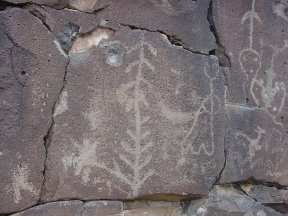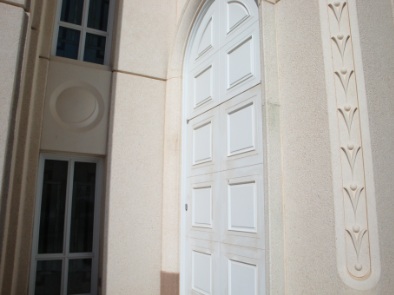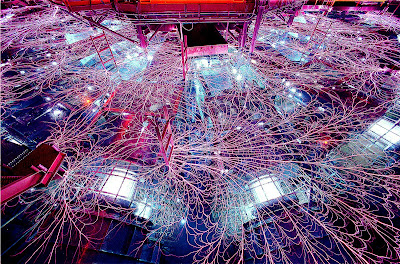
Striations in an electrical discharge tube filled with hydrogen. The left portion is 45.7 centimetres long, the right one 44.4 centimetres. The small tube terminates in a point, the large one in a ring. In the image on top, the point is positively charged, producing 62 disc-shaped strata in the small tube and 12 saucer-shaped ones in the large one. Below, the point is negatively charged, producing 54 disc-shaped strata in the small tube and 13 saucer-shaped ones in the large one. The strata in the small tube were blue, but at times, with a large current, carmine. Copied from photographs, obtained in respectively 15 and 10 seconds. © Warren de la Rue and Hugo W. Müller, 1878
Sep 15, 2011
The mythical landscape is replete with structures alien to the familiar terrestrial environment today.
The term “anomaly” is hardly appropriate for such forms, as it falsely suggests that they constitute a minority. Instead, it would be more accurate to say that puzzling apparitions dominate the scene conjured up in traditional tales. One example of such a mysterious object is the so-called chain of arrows or spears, a concatenation of arrows, or spearheads, each lodging in the butt of the one preceding it, that is suspended from the sky downwards.
Countless myths tell how one or a group of mythical beings brought this curious formation into being, usually in the bygone days of “creation.” For example, the Kaurna tribe, of the Adelaide Plains of South Australia, told that a certain Monana “was one day throwing large spears in various directions, east, west, north, south; when, having thrown one upwards, it did not return to the earth. He then threw another, and another, and so continued throwing; each spear sticking fast to the former one until they reached the ground …”
The lowest segment, required to link the formation to the surface of the earth, tends to be described as crescentic in form, such as a hook, a bow or the upper half of a bird’s beak. Thus, in traditions from the Kutenai, of Idaho, Montana, and British Columbia, “a chain of arrows” is formed by the primordial animals, “which Raven completes by putting his beak in the nock of the last arrow.”
Some traditions intimate that the arrowheads or their correlates, having lodged together, were securely fastened to each other so as to form a veritable “rope” or “chain.” The transition may be accompanied by a shaking of the string. In an account from the Kwā´g˙uł, of northern Vancouver Island, a chain of arrows was fabricated by a certain L!ē´sElag˙iɛla alias “Born-to-be-the-Sun”:
“… he strung his bow, and Born-to-be-the-Sun shot (his arrow) against the upper world. Then he shot another arrow, and still another one, and yet another. Now he had shot all the four arrows. Born-to-be-the-Sun had not looked up long when the arrows came sticking one into the other and struck the ground. They began to stretch out. Then Born-to-be-the-Sun took them and shook them, and they became a rope.”
In some accounts, the loosely embedded constituents of the column subsequently undergo a physical transformation at the expense of the flexibility that typifies a rope or chain; a solid, collinear structure results when a vertical cross-bar strings the superimposed constituents of the cable together and flattened extensions emerge from both sides. For instance, a Kutenai story-teller spoke of “the arrows, which are transformed into a mountain”, identified as Mount Baker, near Cranbrook, British Columbia.
More frequently, the “freezing” of the arrows is stated to have produced a “ladder” or a “stairway.” The Tlingit, of the extreme northwestern coast of British Columbia, report that the son of a great chief woke up to find the chain of arrows he had produced transformed: “After a while he awoke, found himself sleeping on that hill, remembered the arrows he had shot away, and looked up. Instead of the arrows there was a long ladder reaching right down to him.”
The Menik Kaien and the Kintak Bong are two non-Malay groups of Malaysia, who narrate that a certain Tapern “made a ladder up to heaven by shooting a series of darts from his blow-pipe into the air. The first of these stuck into a black cloud, and the others ranged themselves in order below …”
Countless other illustrations of the genre spell out how one or more mythical entities proceeded to ascend to the sky or descend to the earth along a string of arrows or spears, how war ensued between this party and the creatures of the sky, how the connecting cable was eventually severed and how this precluded any further traffic between the realms above and below it, leading to the current division between the stars and the birds in the sky and the people and other animals on earth.
Variations on this story proliferate in the Americas and also circulate in parts of Oceania. In Africa, heaped-up trees or pillars take the place of the arrows, as do stacked mountains or storeyed mountains in Eurasia. How is this theme to be explained?
(To be continued)
Rens Van Der Sluijs
Books by Rens Van Der Sluijs:
The Mythology of the World Axis
The World Axis as an Atmospheric Phenomenon
Shots in the Dark Part Two

Experimental results obtained in 1879 when conducting electricity through rarefied gases in a vacuum tube and modulated by a magnetic field. From left to right, the tube is filled with nitrogen, oxygen, carbon dioxide and tin(IV) chloride. The positive electrode is on top. The tube with nitrogen produced a spiral, the one with carbon dioxide a set of nine stacked toroids embracing a Y-shaped column. (c) John Rand Capron.
Sep 20, 2011
The previous Picture of the Day described several of the many myths that refer to a celestial chain of arrows or a celestial ladder. It asked, how is this theme to be explained?
A significant pointer is the realisation that stories concerning the arrow-chain form a subset of the mythology of the axis mundi, the “cosmic column” that occupies such a prominent position in the sacred traditions of most human cultures. Embedded in this larger body of material, the suspicion that the serried arrows mark a specific stage in the temporal development of the column will not be wide off the mark.
When, during the second part of the nineteenth century, physicists began to experiment with electrical discharges in rarefied gases, they soon discovered that a sustained discharge may exhibit striation and take the form of a row of multiple discs or toroids. Perhaps preceded by the little-known Henry d’Abria in 1843, the Welsh judge and physicist, Sir William Robert Grove (1811-1896), first hit upon the phenomenon in 1852. James Clerk Maxwell (1831-1879) himself observed in 1873:
“Some of the forms of electrical discharge through rare gases are exceedingly remarkable. In some cases there is a regular alternation of luminous and dark strata, so that if the electricity, for example, is passing along a tube containing a very small quantity of gas, a number of luminous disks will be seen arranged transversely at nearly equal intervals along the axis of the tube and separated by dark strata. If the strength of the current be increased a new disk will start into existence, and it and the old disks will arrange themselves in closer order. … These, and many other phenomena of electrical discharge, are exceedingly important, and when they are better understood they will probably throw great light on the nature of electricity as well as on the nature of gases and of the medium pervading space.”
In modern terminology, such “luminous disks” are viewed as a type of plasma instability occurring in z-pinches; informally – though not in the published literature – they have been referred to as “Peratt Instabilities,” after the American plasma physicist, Anthony Peratt.
Although Maxwell’s expectations were aimed at developments in physics, the analysis of such “stacked toroids” or “nested mushrooms” finds a pointed application in the study of human traditions. Reporting on an extensive set of experiments in 1878, Warren de la Rue (1815-1889) and Hugo W. Müller employed a wide variety of imaginative labels to characterise the Peratt Instabilities they obtained, including “luminosities arranged in serpent-like form,” “parallel worm-like entities,” “spheroids,” “disc-shaped strata,” “saucer-shaped strata,” “umbrella-shaped strata,” and “small crescent-shaped disks of red light,” ranging anywhere in number from 2 or 3 to 62. The metaphor of arrows was frequently resorted to as well: an “arrow-headed nebulosity,” “luminosities, part of them arrow-headed, arranged in a wavelike formation,” “arrow-headed luminosities,” “arrow-headed entities,” “luminosities with arrow heads arranged in a spiral,” and so forth.
John Rand Capron (1829-1888) was an English solicitor and amateur astronomer who generated similar toroids and spirals during electrical experiments he performed around 1879 to prove the electrical nature of the aurorae. Moreover, apparently without exception, myths of the arrow-chain type situate that curious configuration in the sky.
For these reasons, only the most spineless of scholars would forbid that such traditions could be based on a conspicuous electric discharge event directly observed in the earth’s atmosphere on one or perhaps a few occasions in the prehistoric past. The energy required for such a plasma tube to form, to glow and to develop “Peratt instabilities” must have been enormous.
A study of the evolutionary stages that would precede as well as follow that of the nested cones might clinch the matter. De la Rue and Müller had already noted that, under some circumstances, “two disks near the negative join together, assuming the form of a double convex lens,” while, under others, “the strata become thicker and fewer; lastly, the current passes with increasing difficulty, and the strata have a tendency to run together.”
Perhaps the latest in a long string of diligent researchers, Peratt has put a firmer backbone into such early researches using cutting-edge technology and simulation software run on the world’s fastest computer. In 2003, he outlined his finding that an initial set of 7 to 9 plasmoids, loosely aligned, will form a rigid “backbone”- or “ladder”- structure under increasing electrical charge. As the current intensifies, the “branches” will begin to warp and merge, until the pinch collapses.
As seen, in the world of mythology, the embedded arrow cones that once led up to the sky run a similar gamut of manifestations and deformations, including the metamorphosis of the pliable string into a rigid ladder or a storeyed mountain and the final disintegration of the latter. With penetrating insight, Peratt also launched the idea that prehistoric petroglyphs categorised as “caterpillars” and “ladders” present visual records of this linear evolution.
The above amounts to circumstantial proof that the earth’s atmosphere once or repeatedly sported a prodigious z-pinch, stratified into an array of discrete plasmoids. With such evidence lined up, the question what unusual physical circumstances could have spawned such a display is surely right on target.
Rens Van der Sluijs
http://mythopedia.info
Books by Rens Van Der Sluijs:
The Mythology of the World Axis
The World Axis as an Atmospheric Phenomenon
Hey Steve, the image/symbol that you refer to from the Las Vegas temple and the rock petroglyphs from Utah can be found throughout the entire ancient world which argues a common origin. Japanese rain chain is a image that comes to mind...

Or this image from the Egyptian Book of the Dead..
Rock Petroglyph
Ancient Chinese manuscript
Now compare with the Las Vegas Temple...
The "chain of arrows archetype", and all the images above can be found in every ancient civilization. The symbols are universal and is interconnected to many other archetypes. The ladder to heaven, pillar of heaven, tree of life, the cosmic mountain, and the axis mundi are a few that come to mind that are interconnected with the chain of arrows.
The symbols are universal, question is, what is the origins?? Hugh Nibley (as was Joseph) was all about origins. Dann W. Hone and James R. Harris don't even touch the topic of origins and don't really acknowledge the universal nature of the symbol you discuss above.
I hope you don't mind me posting a few random thoughts and hope you find this of interest, but there is a man whose research into rock petroglyphs really makes the works of Dann W. Hone and James R. Harris forgettable. I mean that in a nice way. I'm not sure how familiar you are with the Electric Universe? One of the more incredible things about the Electric Universe is that the very same science now being used (Plasma Physics) to understand what we are observing in deep (electromagnetic) space is the very same science being used to understand the ancient world (Myths, rituals, symbols) and the works of Anthony L. Peratt is a incredible example of this (one of many). Peratt is the leading authority in the entire world on high energy Plasma discharges and many Plasma characteristics have been named after him, "Peratt Instabilities". One of Peratts instabilities happens to be the very image depicted on the Las Vegas Temple. Peratt is a Electrical Engineer, Plasma physicist, and Astrophysicist. He is also the protégée of the father of plasma cosmology, the late Hannes Alfvén, who developed the first models of galactic structure and star formation based on electrical principles, and his challenges to the "pure mathematical assumptions" of modern cosmology arose from experimental evidence that can no longer be ignored. (electricity is scalable)
Peratt's own experiments have far-reaching implications when it comes to understanding galaxies, stars, and the evolution of planetary systems. More so than anything you will find in modern science. Modern science is all based on theoretical assumptions with a long list of failed predictions. Than we have Peratt, who can duplicate in the lab exactly what we are seeing in space in scaled down laboratory experiments with a machine that uses 80x the entire worlds output in electricity. The Z-machine. (Z-Pinch)

But the implication of Peratt's latest works into rock petroglyphs cannot be over emphasized. In the late 90s he was introduced to David Talbott (Saturn Myth, Electric Universe, Polar Configuration, Thunderbolts of the Gods) who showed Peratt a wide range of petroglyph themes and he instantly recognized what the images depicted. But this information was classified "Top Secret" by the US government and because of the classified nature Peratt was certain at first that someone had stolen and released "top secret" information. There was no other explanation how anyone could possibly be familiar with the images being produced in the laboratory. It didn't take long for Peratt to realize what he was seeing in the lab was exactly what was portrayed in the ancient rock petroglyphs the world over. To the world the images are foreign, no relation to the world we live and observe today. But to a plasma physicist, there is nothing foreign about the images, they are so easily recognizable. Or you can just take NASA at their word and their theoretical assumption that the rock petroglyphs were produced by aliens. I'm not kidding, that is how foreign the rock images are to NASA that the only logical explanation they can come up with is aliens drew the images. But anyone who knows and understands plasma and electricity (99.99% of the visible universe is plasma) can easily identify the symbols as a plasma discharge, a z-pinch.
Peratt than proceeded to carry out the biggest field research to date on the rock petroglyphs and his conclusions was that these petroglyphs are a recording of a high energy Plasma Discharge event seen in the Earths atmosphere and witnessed by the ancient civilizations. And really, what other explanation could there be except if they were all viewing the same absurd, alien art forms? Just read how extensive his studies were in these matters...
In his investigation of rock art themes, Peratt concentrated his field work in the American Southwest and Northwest, but he also gathered data internationally. For his on-site study he used GPS longitude and latitude positions, always noting the orientation and field of view. A team of about 30 volunteers, including specialists from several fields, assisted Peratt in the investigation, and he has since gathered more than 25,000 rock art images.
Why use GPS? Why would the orientation be important?? Because if the ancients were in fact all viewing and depicting the same thing, chances are all the rock petroglyphs would be facing the same direction of "heaven". If you are trying to copy something you are not going to put the image behind you, you are going to place it side by side. And that is exactly what Peratt discovered.


